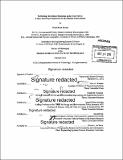Technology investment decisions under uncertainty : a new modeling framework for the electric power sector
Author(s)
Santen, Nidhi
DownloadFull printable version (27.62Mb)
Alternative title
New modeling framework for the electric power sector
Other Contributors
Massachusetts Institute of Technology. Engineering Systems Division.
Advisor
Mort D. Webster.
Terms of use
Metadata
Show full item recordAbstract
Effectively balancing existing technology adoption and new technology development is critical for successfully managing carbon dioxide (CO2) emissions from the fossil-dominated electric power generation sector. The long infrastructure lifetimes of power plant investments mean that deployment decisions made today will influence carbon dioxide emissions long into the future. New technology development and R&D decisions can help reduce the overall costs of reducing emissions, but there are multiple technology investments to choose from, and returns to R&D are inherently uncertain. These features of the technology "deployment versus development" question create unique challenges for decision makers charged with managing cumulative carbon dioxide emissions from the electricity sector. Unfortunately, current quantitative decision support tools ultimately lack one or more of three overarching features jointly necessary to provide useful insights about an optimal balance between R&D program and power plant investments. They lack (1) resolution of the critical structure of the electricity sector, (2) an explicit endogenous representation of the effects of learning-by-searching technological change, and/or (3) an efficient decision-analytic framework to explore multiple technology investment options under uncertainty in the returns to R&D. This dissertation presents a new quantitative decision support framework that allows for the study of socially optimal R&D and capital investment decisions for the power generation sector. Through a novel integration of classical electricity generation investment planning methods, economic modeling of endogenous R&D-driven technological change, and emerging numerical stochastic optimization techniques, the new framework (1) explicitly accounts for the complementary roles that generating technologies play within the electric power system, (2) considers the characteristics of the uncertainty in the technology innovation process, and (3) identifies flexible, adaptive R&D investment strategies for multiple technologies for decision makers to consider. A series of numerical experiments with the new model reveal that (1) the optimal near-term R&D investment strategy under technological change uncertainty and adapting between decisions can be different than the optimal strategy assuming perfect foresight, and may be higher or lower; (2) the timing that a technology should be deployed to meet a specific carbon target dictates the direction and magnitude of the difference in these decisions; (3) increasing the level of uncertainty tends to increase near-term R&D investments; and (4) increasing right-skewness of the uncertainty (i.e., decreasing the likelihood of higher than average returns), reduces R&D spending throughout the planning horizon.
Description
Thesis: Ph. D., Massachusetts Institute of Technology, Engineering Systems Division, February 2013. Cataloged from PDF version of thesis. Includes bibliographical references (pages 303-315).
Date issued
2013Department
Massachusetts Institute of Technology. Engineering Systems DivisionPublisher
Massachusetts Institute of Technology
Keywords
Engineering Systems Division.